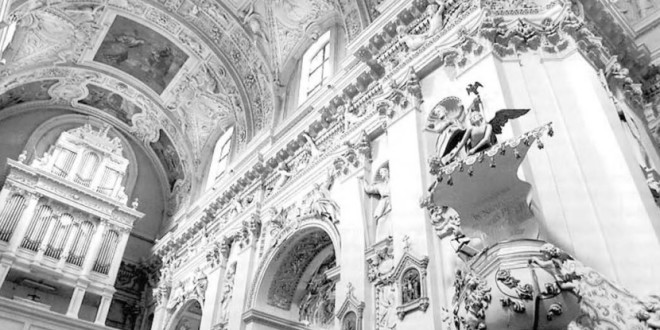By Audrone Kasperaviciene
![]()
It is a myth that both Rome and Vilnius were established by wolves. But it is no myth that the Italians left an indelible mark on Lithuania. For hundreds of years, the spirit of Rome has played a main role in the development ofVilnius, and to a certain degree, of all of Lithuania.
IF YOU WOULD ASK WITH WHICH EUROPEAN Nation were Lithuanians seeking similarities and affinity throughout most of history, we could answer without hesitation — with the Italians. Not only is the Lithuanian language similar to the Latin language, but also the ancient Lithuanian beliefs and traditions were very close to the religion of the ancient Romans. Both nations worshiped almost similar gods (Vulcan and Jupiter of the Romans matched Perkunas or Griaustinis, the Lithuanian god of thunder), and followed similar religious ceremonies: burned a holy fire, worshiped grass-snakes. Lithuanians, like the Romans, had holy forests, in which their gods lived.
The origin of the Lithuanians and the founding of their capital city Vilnius is weaved with legends and tales in which, as a rule, a similarity with remote Italy is stressed.
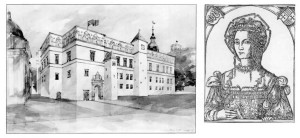
The 15th century Polish historian Jan Dlugosz was convinced that the Lithuanians originated from the Romans. But how did they get to Lithuania, which is so far away from Italy? Dlugosz wrote that a group from a noble Italian family who were supporters of Pompey during the civil war, left Rome with all their wealth and servants escaping from the wrath of Julius Caesar, and settled in Lithuania. The historian believed that the name of their new homeland, “Lituania,” was a corrupted form of the word “L’ltalia.”
Hereinafter the origin of the name of Vilnius is also explained. The name of the leader of the Roman emigrants was Vilius. Dlugosz wrote: “First, they founded the city ofVilnius, which is currently the capital city of the state, and named it after Duke Vilius who led the emigrants out of Italy and brought them to Lithuania. Similar names were given to the two rivers that cross Vilnius – Vilija and Vilnia.”
Even before the conversion of Lithuanians to Catholicism in 1387, a distinctive Lithuanian culture was forming under the influence of western European Gothic culture — particularly that of the cities of the Hanseatic League – and of Byzantine Russian culture. However, from the 16th century on, the influence and input of Italian culture becomes very substantial.
Links with Italy became especially strong during the rule of the Jogailaiciai (Jagellonian) dynasty. However, monuments of this period of Renaissance culture, especially buildings, for the most part did not survive in Vilnius. Most of them were destroyed during the wars with Moscow in the 17th century, and were later reconstructed during the Baroque or Neoclassic periods. Nevertheless, the evolution of the culture of the Lithuanian capital was greatly affected by the Renaissance period, whereas Italian architects, painters, and sculptors would come to Lithuania and settle here until the end of the 18 th century.
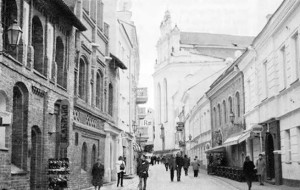
Italian Renaissance came to Vilnius through Hungary due to dynastic links. At the end of the 15th century, members of the Jogailaiciai dynasty held thrones of four central European countries in Prague, Buda, Krakow, and Vilnius. By the beginning of the 16th century, the culture of the Renaissance was already entrenched in the estate of the Grand Duke of Lithuania in Vilnius – the cradle of the Jogailaiciai dynasty.
The future Grand Duke of Lithuania and King of Poland Žygimantas the Old spent three years of his youth (1499-1502) at his brother Vladislovas’ estate in Buda (Hungary), which since the middle of the 15th century was the earliest and most famous center of Renaissance culture in central Europe. M any capable masters from Italy worked there, who Žygimantas knew well. Later these same masters would be employed by Žygimantas himself in Vilnius
Even before his marriage to Bona Sforza, Princess of Milan and Bari, Žygimantas was well acquainted with the aesthetics and culture of Renaissance art and architecture, as well as had established personal contacts with many famous creators of this style. In 1517 the future author of the Žygimantai chapel in Krakow’s Wawel Castle, Bartolommeo Berrecci visited Žygimantas the Old at his residence in Vilnius.
The direct influence of Italian culture predominated in the Vilnius royal estate at the time of Queen Bona Sforza and her son Grand Duke of Lithuania Žygimantas Augustas. We can make strong assumptions about how tight these links were – one of the Q ueen’s housemaids, Francessa Palladia, became the wife of the most famous Renaissance architecture theorist, Sebastiano Serli.
Bona Sforza was one of the most prominent personalities of the Lithuanian Renaissance; her input into the culture, economy, and politics of Poland, Lithuania, and Italy is obvious. In her domains in Lithuania she initiated land reform, which later served as example to her son Žygimantas Augustas for implementing the so-called Valaku (Wallach) land reform throughout all of Lithuania. Bona Sforza also supported the preparation of the code of laws known as the Lithuanian Statutes.
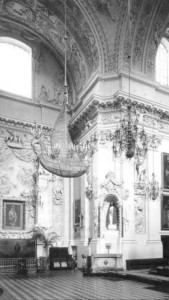
The cultural life of Vilnius especially intensified in the middle of the 16th century when famous musicians, architects, sculptors, doctors, and other courtiers of Bona Sforza settled in Vilnius, and acquired houses and land. Some of them were prominent European personalities, such as the nobleman of Verona, Alessandro Pesenti, an organist at the estate of Cardinal I Ipolito d’Este. After the cardinal’s death in 1521, Pesenti became a courtier of Bona Sforza. This famous musician made a huge input into the development of ecclesiastical music in Vilnius and Krakow. Around 1535 he became the canon of Vilnius Cathedral. The Lithuanian Metrica records that Pesenti had extensive real estate holdings in and around Vilnius.
Thanks to Bona Sforza, at the beginning of the 16th century – and quite early for Lithuania – the growing of certain vegetables unknown to northern and eastern European countries, was started. Their Lithuanian names show their Italian origin: cabbage (in Lithuanian – “kopustai,” in Italian – “kapucci”); cauliflower (in Lithuanian – “kalafiorai,” in Italian – “cavolo fiore”); kohlrabi (in Lithuanian – “kaliarope,” in Italian – “cavolo rapa”); leek (in Lithuanian – “poras,” in Italian – “pori”); parsley (in Lithuanian – “petražole”, in Italian – “petrosello”); cannabis (in Lithuanian – “kanape,” in Italian – “cannapa”); tomato (in Lithuanian – “pomidoras,” in Italian – “pomi d’oro”). Bona Sforza started cultivated these foreign plants in her many gardens, which, according to historical documents she had in Vilnius in the territory of the castles and in other places.
The Tuscany type of Italian Renaissance influenced 16th century Vilnius architecture. One of the first Italian architects to come to the Lithuanian capital was Giovanni Cini, arriving from Settignano near Siena. Together with Bernardino Zanobi de Gianotis and Filippo da Fesole, he rebuilt Vilnius Cathedral after the fire of 1534. Beginning in 1540, he completed many smaller assignments in Vilnius, and participated in the reconstruction and expansion of the Lower Castle. He settled permanently in Vilnius in 1547, where he headed construction crews, and possibly remained there until his death. Generous salaries, paid to him from the Grand Duke’s treasury, allow us to think that he headed the construction and decoration work of the Lower Castle. He also might have been the author of the entire project. Giovanni Cini collaborated with Bernardino Zanobi de Gianotis, who was born in Florence and came to Vilnius in 1517, probably from Rome. It is believed that Gianotis created the tombstone of the magnate V. Goš tautas (d. 1539) inside Vilnius Cathedral. The earlier mentioned Filippo da Fesole also belonged to the same workshop of architects.
In 1579, when Vilnius’ Jesuit Academy (later Vilnius University) was established, control of construction by the Jesuits was overtaken by the headquarters of the Jesuit Order in Rome and senior architects of the Order in its various provinces. In Lithuania such senior architect was Giovanni Maria Bernardoni — a student of the first Jesuit Architect General Giovanni Tristano — who worked there from 1583. He was regarded as a good designer who often collaborated with local architects.
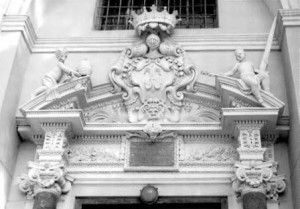
As a rule, the Jesuit architects who worked in the Grand Duchy of Lithuania were not too demanding, so the churches and schools designed by them were usually built by the local craftsmen. These buildings were not as perfect in proportion as the creations of Vinjola or Giacomo della Porta in Rome. Nevertheless, there were many experienced architects and builders among the Jesuits who were sent by the Order from one construction project to another for supervision and advise to the local masters. This way, local construction traditions were supplemented with new stylistic elements. Construction ofVilnius University, the most significant center of Jesuit ideology in northern Europe, certainly had to be in the center of attention of Rome’s Architect General.
The activity of the Jesuits in the territory of the Grand Duchy of Lithuania is evidenced by the fact that here the composition principles of the Holy Name of Jesus church in Rome, known as II Gesu, were applied earlier than anywhere else in Europe. Five years after the construction of this church, the Jesuit architect Giovanni Maria Bernardoni repeated those same composition principles in the church he built in Nesvyžius (present-day Belarus) in 1589. The architecture of the Grand Duchy of Lithuania at that time was influenced by Rome-driven avant-garde principles for organizing the design of internal spaces and the facade as an independent composition.
The Baroque period in Vilnius until the middle of the 17th century is characterized by historians as a time of further advancement of Lithuanian culture, full of creativity, ambition, and attraction to novelty. The first half of the 17th century was very favorable for the economic prosperity of the Grand Duchy, and particularly its capital Vilnius. In 1618- 1648, during the Thirty-Year-War, Europe faced famine and plagues. Lithuanian magnates exported grain from the Grand Duchy’s rich eastern and southern fields (Byelorussia and Ukraine) to the fighting European countries and, at the same time, attracted talented architects and craftsmen to Vilnius by offering them good remuneration.
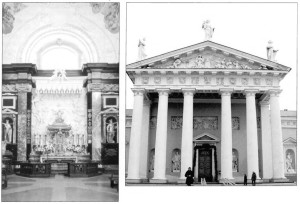
It is believed that the architect Matteo Castello, a representative of Rome’s early Baroque Maderno circle, was working in Vilnius at the beginning of the 17th century. After coming to Vilnius, he found the Baroque style already vibrant at the estate of Grand Duke Žygimantas III Vasa. During the rule of the Vasa dynasty (1587-1669), sculptors, architects, musicians, and other artists and artisans were further widely invited from Italy. Among them was Constantino Tencalla, who built Saint Casimir’s chapel next to Vilnius Cathedral. The Italian sculptor Giovanni Pietro Perti created the altar of the chapel in 1686-1688. The walls of the chapel were decorated with the frescos “Opening of Saint Casimir’s coffin” and “The miracle near Saint Casimir’s coffin” by the Italian painter, Michelangelo Palloni in 1692. Tencalla was also the architect of Saint Teresa’s Church, one of the earliest Baroque churches in Vilnius.
During the period of the CounterReformation, the magnates of Vilnius, who were reverting back to Catholicism, engaged in much building. Following the example of Rome, extravagant religious processions were held, and triumphal arches and altars were built in the streets and squares decorated with symbols, allegories, banners. In time these “Italian events” became an inseparable part of the cultural traditions of Vilnius’ society.
In the second part of the 17th century, Lithuanian Baroque architecture was influenced not only by members of the Roman and Milan schools, but also by masters of the Perti di Muja, Gali di Rovi, and other dynasties from the Italian region of Switzerland. They came to Lithuania through Bohemia and Bavaria. These masters created the spectacular interiors of Sts Paul and Peter Church, the Trinitarian Church, and the earlier mentioned altar of Saint Casimir’s chapel. They also built and decorated the Pažaislis monastery complex near Kaunas. This, one of the most famous monuments of Lithuanian Baroque was created by a number of talented Italian artists. The construction of the Pažaislis church was began in 1667 according to designs by the architect Giambattista Frediani. Stucco decorations were created by Giovanni Merli; frescos were started by Michelangelo Palloni in 1674-1684, and completed by J. Rosi. After 1674 the construction of the church was headed by Carlo and Pietro Putini.
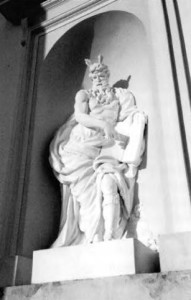
After the suppression of the Jesuit Order, cultural links with Italy did not end.
The fist appearance of Neoclassicism in Vilnius is also connected with Italy. The young Italian architect Carlo Spampani, who was invited from Rome in 1773, created a Dorian style portal with sculptures in the western wall of the W hite Hall of Vilnius University’s Observatory.
The most famous masters of Lithuanian Neoclassicism studied in Rome: the painter Pranciškus Smuglevicius (from 1765 at the St. Lucas Art Academy), and the architect Laurynas Stuoka-Gucevicius (in 1776- 1777) who reconstructed Vilnius Cathedral and designed many other buildings in the new style.
In 1784 the bishop ofVilnius, Ignas J. Masalskis invited the famous Italian sculptor Tomas Righi, who was a distinguished member of the St. Lucas Art Academy in Rome, to come to Vilnius. Into the six niches of the western facade of the new Cathedral the sculptor integrated double-size figures of the four Evangelists flanked by sculptures of Abraham and Moses. The niches and the gable at the top of the facade were decorated with bas-relief compositions of themes from the Bible. The sculptor worked in Vilnius for more than six years. These sculptures of Tomas Righi are the last examples of Baroque in Vilnius.
In 1795, after Lithuania lost its sovereignty and became a province of the Russian empire, its cultural links with Italy greatly weakened.
 DRAUGAS NEWS Lithuanian World Wide News in English
DRAUGAS NEWS Lithuanian World Wide News in English
